Abstract
Three different molecular markers (i.e. seven allozyme loci, two nuclear gene loci and, mtCOI DNA sequences) were used to assess the genetic structure of the vent gastropod Lepetodrilus elevatus collected from three vent fields along the East Pacific Rise (13°N, 9°50′N and 17°S). While allozymes and nuclear loci suggested a strong stepping-stone pattern, a multivariate analysis performed on allozymic frequencies showed the presence of two distinct evolutionary lineages: the first situated in the north from 13°N to 9°50′N and the second in the south from 9°50′N to 17°S. The analysis of mitochondrial DNA sequences confirmed the separation of L. elevatus into two distinct clades with a divergence of 6.5%, which is consistent with the interspecific level of sequence variation in other vent species. A divergence time of 6–14 Mya was estimated between the two clades from previous clock calibrations. Our results suggest that these taxa followed an allopatric speciation between the northern and southern parts of the EPR with a recent demographic expansion of the southern clade to the north and a subsequent secondary contact (clade hybridisation). This speciation was probably reinforced by a habitat specialisation of the two cryptic species because the southern clade was mainly found associated with mussel-dominated communities and the northern clade with tubeworm-dominated communities. However, the analysis of shell morphology failed to separate the two cryptic species based on this sole criterion although they differed from Lepetodrilus elevatus galriftensis (Galapagos population) by a higher shell elevation. Within each clade, genetic differentiation was not related to the distance across populations and could be within vent field as important as between fields. While both clades appear to be in expansion since their speciation, significant excesses in heterozygotes suggest a very recent and local bottleneck at 17°S, probably due to massive site extinction in this region.









Similar content being viewed by others
References
Avise JC, Wollenberg K (1997) Phylogenetics and the origin of species. Proc Biol Soc Wash 94:7748–7755
Bandelt HJ, Forster P, Röhl A (1999) Median-joining networks for inferring intraspecific phylogenies. Mol Biol Evol 16:37–48
Bazin E, Glemin S, Galtier N (2005) Population size does not influence mitochondrial genetic diversity in animals. Science 312:570–572
Belkhir K, Borsa P, Chikhi L, Raufaste N, Bonhomme F (1996–2004) GENETIX 4.05, logiciel sous Windows™ pour la génétique des populations. Laboratoire Génome, Populations, Interactions. CNRS UMR 5000, Université de Montpellier II, Montpellier (France)
Black MB, Lutz RA, Vrijenhoek RC (1994) Gene flow among vestimentiferan tube worm (Riftia pachyptila) populations from hydrothermal vents of the eastern Pacific. Mar Biol 120:33–39
Black MB, Trivedi A, Maas PAY, Lutz RA, Vrijenhoek RC (1998) Population genetics and biogeography of vestimentiferan tube worms. Deep Sea Res II 45:365–382
Chevaldonné P, Jollivet D, Vangriesheim A, Desbruyères D (1997) Hydrothermal-vent alvinellid polychaete dispersal in the eastern Pacific. 1. Influence of vent site distribution, bottom currents, and biological patterns. Limnol Oceanogr 42:67–80
Chevaldonné P, Jollivet D, Desbruyères D, Lutz RA, Vrijenhoek RC (2002) Sister-species of eastern Pacific hydrothermal vent worms (Ampharetidae, Alvinellidae, Vestimentifera) provide new mitochondrial COI clock calibration. Cah Biol Mar 43:367–370
Cornuet JM, Luikart G (1996) Description and power analysis of two tests for detecting recent population bottlenecks from allele frequency data. Genetics 144:2001–2014
Craddock C, Lutz RA, Vrijenhoek RC (1997) Patterns of dispersal and larval development of archaeogastropod limpets at hydrothermal vents in the eastern Pacific. J Exp Mar Biol Ecol 210:37–51
Desbruyères D, Segonzac M, Bright M (2006) Handbook of deep-sea hydrothermal vent fauna, 2nd edn. Denisia 18:1–544
Desmarais E, Lanneluc I, Lagnel J (1998) Direct amplification of length polymorphism (DALP), or how to get and characterise new genetic markers in many species. Nucleic Acids Res 26:1458–1465
Folmer O, Black MB, Hoeh WR, Lutz RA, Vrijenhoek RC (1994) DNA primers for the amplification of mitochondrial cytochrome oxydase subunit 1 from diverse metazoan invertebrates. Mol Mar Biol Biotechnol 3:294–299
Fu YX, Li WH (1993) Statistical tests of neutrality of mutations. Genetics 133:693–709
Goffredi SK, Hurtado LA, Hallam S, Vrijenhoek RC (2003) Evolutionary relationships of deep-sea vent and cold seep clams (Mollusca: Vesicomyidae) of the “pacifica/lepta” species complex. Mar Biol 142:311–320
Goodacre SL, Wade CM (2001) Patterns of genetic variation in Pacific Island land snails: the distribution of cytochrome b lineages among Society Island Partula. Biol J Linn Soc 73:131–138
Goudet J (2001) FSTAT, a program to estimate and test gene diversities and fixation indices (version 2.9.3). Available from http://www.unil.ch/izea/softwares/fstat.html. Updated from Goudet J (1995) FSTAT (vers. 1.2): a computer program to calculate F-statistics. J Hered 86:485–486
Guinot D, Hurtado LA (2003) Two new species of hydrothermal vent crabs of the genus Bythogrea from the southern East Pacific Rise and from the Galapagos rift (Crustacea Decapoda Brachyura Bythograeidae). C R Biol 326:423–439
Haymon RM, Fornari DJ, Edwards MH, Carbotte S, Wright D, McDonald KC (1991) Hydrothermal vent distribution along the East Pacific Rise Crest (9°09′–54′N) and its relationship to magmatic and tectonic processes on fast-spreading mid-ocean ridges. Earth Planet Sci Lett 104:513–534
Hurtado LA, Mateos M, Lutz RA, Vrijenhoek RC (2002) Molecular evidence for multiple species of Oasisia (Annelida: Siboglinidae) at eastern Pacific hydrothermal vents. Cah Biol Mar 43:377–380
Hurtado LA, Lutz RA, Vrijenhoek RC (2004) Distinct patterns of genetic differentiation among annelids of eastern Pacific hydrothermal vents. Mol Ecol 13:2603–2615
Johnson SB, Young CR, Jones WJ, Warén A, Vrijenhoek RC (2006) Migration, isolation, and speciation of hydrothermal vent limpets (Gastropoda; Lepetodrilidae) across the Blanco Transform Fault. Biol Bull 210:140–157
Jollivet D (1996) Genetic diversity and biodiversity at deep-sea hydrothermal vents: an overview. Biodivers Conserv 5:1619–1653
Jollivet D, and the Shipboard Scientific Party (2005) The BIOSPEEDO cruise: a new survey of hydrothermal vents along the South East Pacific Rise from 7°24′S to 21°33′S. InterRidge News 13:20–26
Jollivet D, Desbruyères D, Moraga D, Bonhomme F (1995) Genetic differentiation of deep-sea hydrothermal vent alvinellid populations (Annelida: Polychaeta) along the East Pacific Rise. Heredity 74:376–391
Jollivet D, Chevaldonné P, Planque B (1999) Hydrothermal-vent alvinellid polychaete dispersal in the eastern Pacific. 2. A metapopulation model based on habitat shifts. Evolution 53:1128–1142
Karl SA, Schutz SJ, Desbruyères D, Lutz RA, Vrijenhoek RC (1996) Molecular analysis of gene flow in the hydrothermal-vent clam Calyptogena magnifica. Mol Mar Biol Biotech 5:193–202
Kimura M, Weiss GH (1964) The stepping stone model of population structure and the decrease of genetic correlation with distance. Genetics 49:561–576
Knowlton N (1993) Sibling species in the sea. Annu Rev Ecol Syst 24:189–216
Knowlton N (2000) Molecular genetic analyses of species boundaries in the sea. Hydrobiologia 420:73–90
Luikart G, Allendorf FW, Cornuet JM, Sherwin WB (1998) Distortion of allele frequency distributions provides a test for recent population bottlenecks. J Hered 89:238–247
Lutz RA, Bouchet P, Jablonski D, Turner RD, Warén A (1986) Larval ecology of molluscs at deep-sea hydrothermal vents. Am Malacol Bull 4:49–54
McLean JH (1988) New archaeogastropod limpets from hydrothermal vents: superfamily Lepetodrilacea. I. Systematic descriptions. Philos Trans R Soc Lond B 319:1–32
Mammerickx J, Herron E, Dorman L (1980) Evidence for two fossil spreading ridges in the southeast Pacific. Geol Soc Am Bull 91:263–271
Marsh AG, Mullineaux LS, Young CM, Manahan DT (2001) Larval dispersal potential of the tubeworm Riftia pachyptila at deep-sea hydrothermal vents. Nature 411:77–80
Metaxas A (2004) Spatial and temporal patterns in larval supply at hydrothermal vents in the northeast Pacific ocean. Limnol Oceanogr 49:1949–1956
Mosimann JE (1970) Size allometry: size and shape variables with characterizations of the lognormal and generalized gamma distributions. J Am Stat Assoc 65:930–945
Mosimann JE, James FC (1979) New statistical methods for allometry with application to Florida red-winged blackbirds. Evolution 33:444–459
Mullineaux LS, Wiebe PH, Baker ET (1995) Larvae of benthic invertebrates in hydrothermal vent plumes over Juan de Fuca Ridge. Mar Biol 122:585–596
Mullineaux LS, Mills SW, Sweetman AK, Beaudreau AH, Metaxas A, Hunt HL (2005) Vertical, lateral and temporal structure in larval distributions at hydrothermal vents. Mar Ecol Prog Ser 293:1–16
O’Mullan GD, Maas PAY, Lutz RA, Vrijenhoek RC (2001) A hybrid zone between hydrothermal vent mussels (Bivalvia: Mytilidae) from the Mid-Atlantic Ridge. Mol Ecol 10:2819–2831
Palumbi SR (1994) Genetic divergence, reproductive isolation, and marine speciation. Annu Rev Ecol Syst 25:547–572
Pasteur N, Pasteur G, Bonhomme F, Catalan J, Britton-Davidan J (1987) Manuel technique de génétique par électrophorèse des protéines. Lavoisier, Paris
Peek AS, Gustafson RG, Lutz RA, Vrijenhoek RC (1997) Evolutionary relationships of deep-sea hydrothermal vent and cold-water seep clams (Bivalvia: Vesicomyidae): results from the mitochondrial cytochrome oxidase subunit I. Mar Biol 130:151–161
Posada D, Crandall KA (1998) MODELTEST: testing the model of DNA substitution. Bioinformatics 14:817–818
Pradillon F, Shillito B, Young CM, Gaill F (2001) Developmental arrest in vent worm embryos. Nature 413:698–699
Ramos-Onsins SE, Rozas J (2002) Statistical properties of new neutrality against population growth. Mol Biol Evol 19:2092–2100
Rozas J, Sanchez-DelBarrio JC, Messeguer X, Rozas R (2003) DnaSP, DNA polymorphism analyses by the coalescent and other methods. Bioinformatics 19:2496–2497
Sambrook J, Fritsch EF, Maniatis T (1989) Molecular cloning: a laboratory manual. 2nd Edn. Cold Spring Harbor Press, Cold Spring Harbor
Schneider S, Roessli D, Excoffier L (2000) Arlequin (V2.0): Software for population genetics data analysis. Genetics and biometry laboratory, Department of Anthropology, University of Geneva, Geneva
Slatkin M (1993) Isolation by distance in equilibrium and non-equilibrium populations. Evolution 47:264–279
Southward EC, Tunnicliffe V, Black M (1996) Revision of the species Ridgeia from northeast Pacific hydrothermal vents, with a redescription of Ridgeia piscesae Jones (Pogonophora: Obturata = Vestimentifera). Can J Zool 73:282–295
Swofford DL (2002) PAUP*. Phylogenetic analysis using parsimony (*and other methods), Version 4. Sinauer Associates, Sunderland, Massachusetts
Tunnicliffe V, Fowler CMR (1996) Influence of sea-floor spreading on the global hydrothermal fauna. Nature 379:531–533
Van Dover CL (2000) The ecology of deep-sea hydrothermal vents. Princetown University Press, Princetown
Van Dover C, German CR, Speer KG, Parson LM, Vrijenhoek RC (2002) Evolution and biogeography of deep-sea vent and seep invertebrates. Science 295:1253–1257
Vrijenhoek RC (1997) Gene flow and genetic diversity in naturally fragmented metapopulations of deep-sea hydrothermal vents animals. J Hered 88:285–293
Vrijenhoek RC, Shank TM, Lutz RA (1998) Gene flow and dispersal in deep-sea hydrothermal vent animals. Cah Biol Mar 39:363–366
Warén A, Bouchet P (2001) Gastropoda and Monoplacophora from hydrothermal vents and seeps; new taxa and records. Veliger 44:116–231
Weir BS, Cockerham CC (1984) Estimating F-statistics for the analysis of population structure. Evolution 38:1358–1370
Won Y, Young CR, Lutz RA, Vrijenhoek RC (2003) Dispersal barriers and isolation among deep-sea mussel populations (Mytilidae: Bathymodiolus) from eastern Pacific hydrothermal vents. Mol Ecol 12:169–184
Wright S (1943) Isolation by distance. Genetics 28:114–138
Acknowledgements
We thank the crew and pilots of the RV Atalante and the DSV Nautile for their assistance and technical support during the cruises HOPE’99 and BioSpeedo’04. We also thank François Lallier, chief scientist of the HOPE’99 cruise who allowed us to collect material. We are indebted to T. Shank and J.H. McLean who provided samples from the 9°50′N vent field and Galapagos Rift, respectively. We also thank the platform GENOMER for sequences acquisition and P. Labbe and J. de Barry for their help in DALP markers production. This work was partly funded by the programme Dorsales and the GDR Ecchis (Ifremer, CNRS). It is a part of M.M. PhD thesis supported by a grant from the French Ministry of National Education and Research.
Author information
Authors and Affiliations
Corresponding author
Additional information
Communicated by S.A. Poulet.
Rights and permissions
About this article
Cite this article
Matabos, M., Thiébaut, E., Le Guen, D. et al. Geographic clines and stepping-stone patterns detected along the East Pacific Rise in the vetigastropod Lepetodrilus elevatus reflect species crypticism. Mar Biol 153, 545–563 (2008). https://doi.org/10.1007/s00227-007-0829-3
Received:
Accepted:
Published:
Issue Date:
DOI: https://doi.org/10.1007/s00227-007-0829-3




